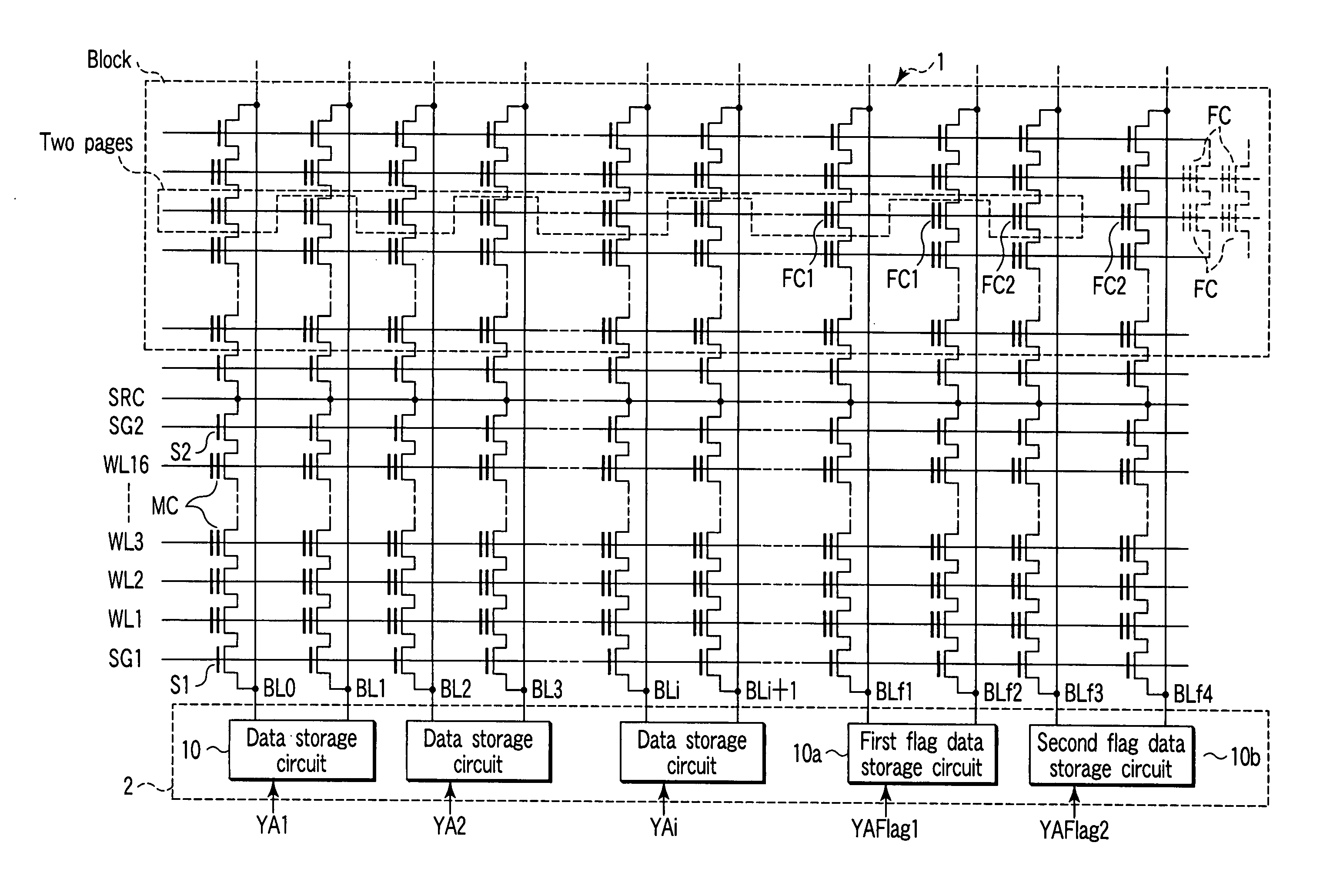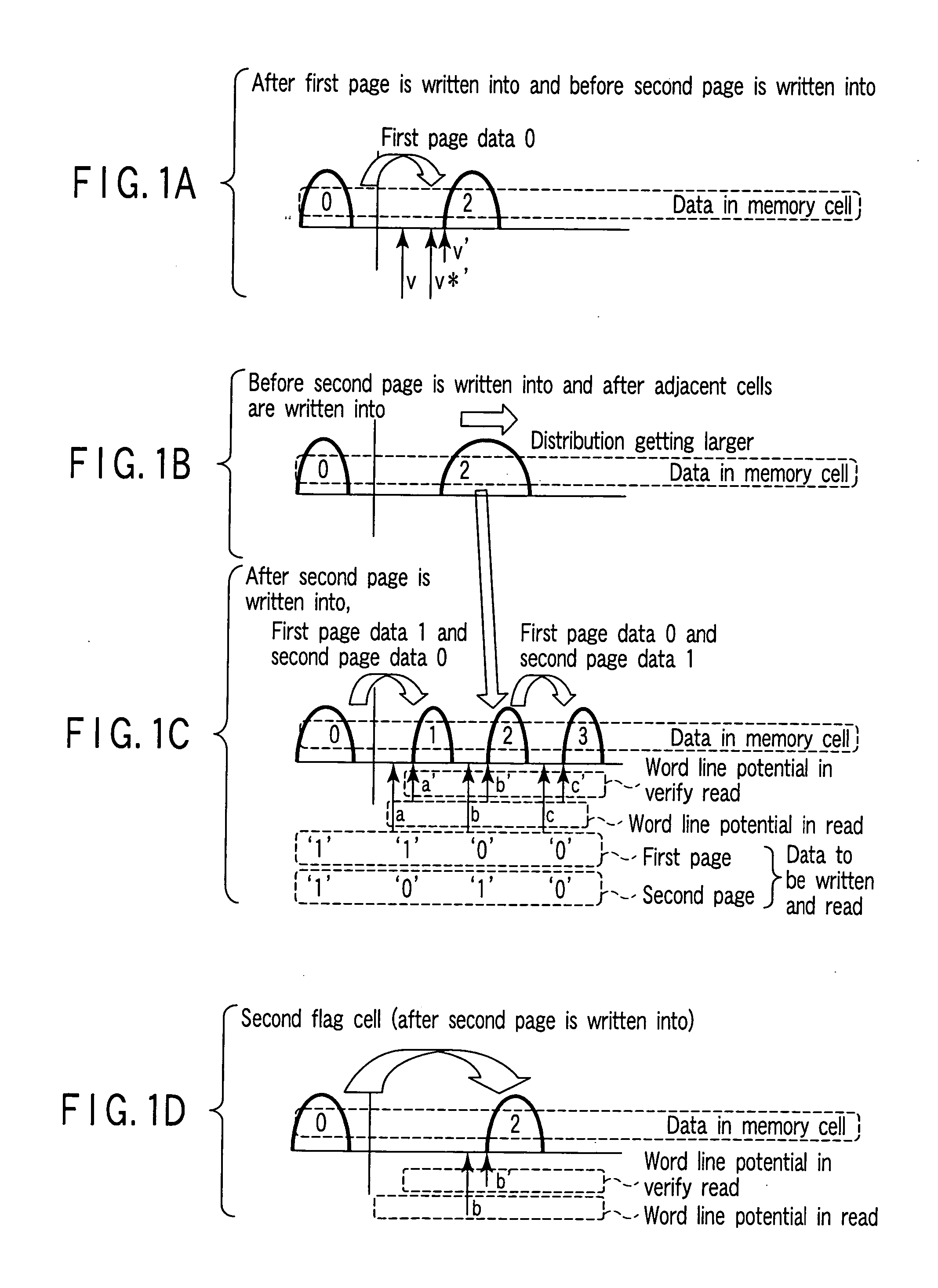Semiconductor memory device which stores plural data in a cell
a memory device and memory technology, applied in the field of semiconductor memory devices, can solve the problems of long time to carry and difficulty in speeding up data write operations
- Summary
- Abstract
- Description
- Claims
- Application Information
AI Technical Summary
Benefits of technology
Problems solved by technology
Method used
Image
Examples
first embodiment
[0087]FIG. 2 schematically shows the configuration of a nonvolatile semiconductor memory device according to a first embodiment of the present invention. For example, the configuration of a NAND flash memory which stores 4-valued (2 bits of) data is shown in FIG. 2.
[0088] A memory cell array 1 includes a plurality of bit lines, a plurality of word lines, and a common source line. In the memory array 1, for example, memory cells are arranged in a matrix. Each of the memory cells is composed of an EEPROM cell and enables data to be rewritten electrically. A bit line control circuit 2 for controlling the bit lines and a word line control circuit 6 are connected to the memory cell array 1.
[0089] The bit line control circuit 2 includes a plurality of data storage circuits and a flag data storage circuit as described later. The bit line control circuit 2 reads the data in a memory cell in the memory cell array 1 via a bit line, detects the state of a memory cell in the memory cell array...
second embodiment
[0262]FIG. 19 shows a memory cell array 1 and a bit line control circuit 2 in a NAND flash memory for storing 8-valued (3 bits of) data according to a second embodiment of the present invention. Since the configuration of FIG. 19 is almost the same as the configuration for 4-valued (2 bits of) data shown in FIG. 3, only the part differing from the configuration of FIG. 3 will be explained.
[0263] In FIG. 19, when one word line is selected by an external address, then one sector shown by a broken line is selected. One sector is composed of three pages. An address is used to switch between the three pages. Specifically, since 3 bits of data can be stored in a memory cell, the switching between three bits is done by an address (a first page, a second page, and a third page). One sector has five flag cells FC1, FC2, FC3, FC4, and FC5 (FIG. 19 shows only flag cells FC1 and FC5). Therefore, when one word line is selected, the five flag cells FC1, FC2, FC3, FC4, and FC5 are selected at the...
third embodiment
[0353] In the second embodiment, the flag cells FC1 to FC5 have written into as follows. When the second page is written into, the flag cell FC1 is written into to the verify potential “b*′” and the flag cell FC2 is written into to the verify potential “d*′”. When the third page is written into, the flag cell FC3 is written into to the verify potential “a′”, the flag cell FC4 is written into to the verify potential “b′”, and the flag cell FC5 is written into to the verify potential “d′”. For this reason, the second embodiment uses five flag cells. However, the flag cell FC1 can be substituted for the flag cell FC4 and the flag cell FC2 can be substituted for the flag cell FC5. Therefore, the circuit shown in FIG. 19 can be composed of three flag data storage circuits and three flag cells FC1, FC2, and FC3.
[0354] In the above configuration, the first and second page write operations are the same as in the second embodiment. The third page write operation differs a little from that i...
PUM
 Login to View More
Login to View More Abstract
Description
Claims
Application Information
 Login to View More
Login to View More - Generate Ideas
- Intellectual Property
- Life Sciences
- Materials
- Tech Scout
- Unparalleled Data Quality
- Higher Quality Content
- 60% Fewer Hallucinations
Browse by: Latest US Patents, China's latest patents, Technical Efficacy Thesaurus, Application Domain, Technology Topic, Popular Technical Reports.
© 2025 PatSnap. All rights reserved.Legal|Privacy policy|Modern Slavery Act Transparency Statement|Sitemap|About US| Contact US: help@patsnap.com



